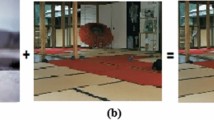Abstract
Splicing is one of the most common tampering techniques for image manipulation in many forensic cases. In this paper, a novel detection method which can expose splicing manipulation by discerning the inconsistencies of color shift in splicing images is presented. Color temperature varies dramatically in formation of different images due to photographic light sources, and always leads to color shift in an image, though it sometimes is imperceptible for human visualization. Therefore color shift can be taken as one kind of optical fingerprint of images for authentication. In this study, we proposed a color shift estimation based method to authenticate the presented images by localizing splicing manipulations automatically. These quantitative evidences contribute a lot to forensic investigators. This method comprises three steps: firstly it estimates the color shift of local partitions and the whole image; secondly exposes inconsistency in color shift by calculating distances between them as an indicator; and finally classifies these partitions into different classes by an optimized threshold. In our proposed method, color shift is estimated by using color constancy algorithm, which has been widely applied in cameras as AWB (automated white balance) to correct color shift in captured images. The following experiments exhibits the effectiveness of the proposed method with visual and quantitative evaluation.




Similar content being viewed by others
References
Farid H (2009) A survey of image forgery detection. IEEE Signal Process Mag 26(2):16–25
Farid H (2010) Image forensic analyses that elude the human visual system. Proc SPIE 7541:754106
Johnson MK, Farid H (2005) Exposing digital forgeries by detecting inconsistencies in lighting. In: Proceeding of the Workshop on Multimedia & Security, DBLP, pp 1–10.
O'Brien JF, Farid H (2012) Exposing photo manipulation with inconsistent reflections. ACM Trans Graph 31(1):1–11
Carvalho TJD, Riess C, Angelopoulou E, Pedrini H, Rocha ADR (2013) Exposing digital image forgeries by illumination color classification. IEEE Transactions on Information Forensics and Security 8(7):1182–1194
Kee E, O'Brien JF, Farid H (2012) Exposing photo manipulation with inconsistent shadows. ACM Trans Graph 32(3):1–11
Kee E, O'Brien JF, Farid H (2014) Exposing photo manipulation from shading and shadows. ACM Trans Graph 33(5):1935–1946
Xiao Q, Wang H, Li F, Gao Y (2011) 3D object retrieval based on a graph model descriptor. Neurocomputing 74(17):3486–3493
Xiao Q, Yichuang L, Wang H (2014) Motion retrieval based on switching Kalman filters model. Multimed Tools Appl 72(1):951–966
Lee MH, Seo DK, Seo BK, Park JI (2009) Optimal illumination for discriminating objects with different spectra. Opt Lett 34(17):2664–2666
Li CJ, Cui GH, Melgosa M, Ruan XK, Zhang YJ, Ma L, Xiao KD, Luo M (2016) Accurate method for computing correlated color temperature. Opt Express 24(13):14066–14078
Huo JY, Chang YL, Wang J, Wei XX (2006) Robust automatic white balance algorithm using gray color points in images. IEEE Trans Consum Electron 52(2):541–546
Zhang XS, Gao SB, Li RX, Du XY, Li CY, Li YJ (2016) A retinal mechanism inspired color constancy codel. IEEE Trans Image Process 25(3):1219–1232
Gao SB, Zhang M, Li CY, Li YJ (2017) Improving color constancy by discounting the variation of camera spectral sensitivity. Journal of the Optical Society of America A-Optics Image Science and Vision 34(8):1448–1462
Qinkun X, Ren S (2018) Action recognition based on hierarchical dynamic Bayesian network. Multimed Tools Appl 77(6):6955–6968
Gijsenij A, Lu R, Gevers T (2012) Color constancy for multiple light sources. IEEE Trans Image Process 21(2):697–709
Nakano N, Nishimura R, Sai H, Nishizawa A, Komatsu H (1998) Digital still camera system for mega pixel CCD. IEEE Trans Consum Electron 44(3):581–586
Lee J, Jung Y, Kim B, Ko SJ (2001) An advanced video camera system with robust AF, AE and AWB control. IEEE Trans Consum Electron 47(3):694–699
Zhou RZ, He J, Hong ZL (2005) Adaptive algorithm of auto white balance for digital camera. Journal of Computer-Aided Design and Computer Graphics 17(3):529–533
Danielsson PE (1980) Euclidean distance mapping. Computer Graphics and Image Processing 14(3):227–248
Nobuyuki O (2007) A Threshold selection method from gray-level histograms. IEEE Transactions on Systems, Man, and Cybernetics: Systems 9(1):62–66
Ng TT, Hsu J, Chang SF. Columbia image splicing detection evaluation dataset. http://www.ee.columbia.edu/ln/dvmm/downloads/AuthSplicedDataSet/photographers.htm
Christlein V, Riess C, Jordan J, Riess C, Angelopoulou E (2012) An evaluation of popular copy-move forgery detection approaches[J]. IEEE Transactions on Information Forensicsand Security 7(6):1841–1854
Chang X, Ma Z, Lin M et al (2017) Feature interaction augmented sparse learning for fast Kinect motion detection[J]. IEEE Trans Image Process:3911–3920
Chang X, Nie F, Wang S, Yang Y, Zhou X, Zhang C (2016) Compound rank-k projections for bilinear analysis[J]. IEEE Transactions on Neural Networks and Learning Systems 27(7):1502–1513
Sun P, Lang Y, Fan S, Shen Z, Liu L, Shan D, Peng S (2018) Exposing splicing forgery based on color temperature estimation[J]. Forensic Sci Int 289:1–11
Acknowledgements
“This work was supported in part by Natural National Science Foundation of China (NSFC) (61307016). National Key R&D Program (2017YFC0822204). National Engineering Laboratory of Evidence Traceability Technology (2017NELKFKT09).”
Author information
Authors and Affiliations
Corresponding author
Additional information
Publisher’s note
Springer Nature remains neutral with regard to jurisdictional claims in published maps and institutional affiliations.
Rights and permissions
About this article
Cite this article
Zhe, S., Peng, S. Authentication of splicing manipulation by exposing inconsistency in color shift. Multimed Tools Appl 79, 8235–8248 (2020). https://doi.org/10.1007/s11042-019-08565-2
Received:
Revised:
Accepted:
Published:
Issue Date:
DOI: https://doi.org/10.1007/s11042-019-08565-2




